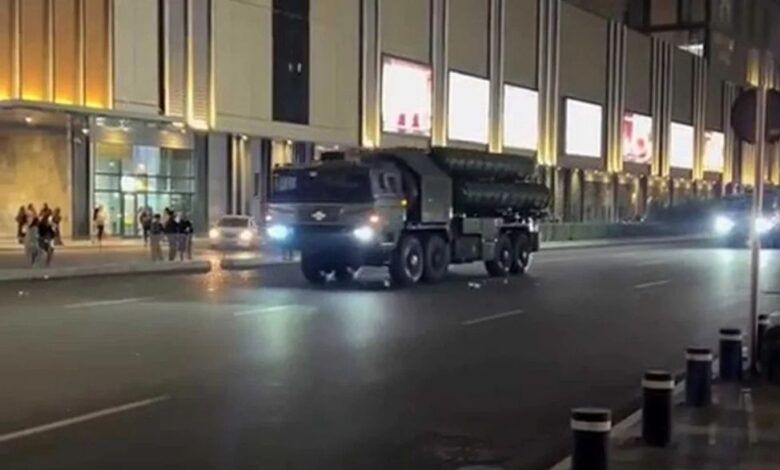Azerbaijan is gearing up for a grand victory parade commemorating the fifth anniversary of its landmark success in 2020. This event is not only a celebration for the Azerbaijani people but also a strategic showcase of the nation's military strength to both allies and adversaries. For days now, the streets of Baku have echoed with the rumble of military vehicles, while Azerbaijani fighter jets have been performing aerial manoeuvres in the city’s skies.
This surge of patriotic activity has instilled a deep sense of pride among Baku residents. At the same time, public attention is focused on identifying new weaponry that enhances the capabilities of the Azerbaijani Armed Forces. Amid these preparations, a photograph taken on one of Baku’s parade routes has captured widespread attention — not only within Azerbaijan but across the globe. The image features the Chinese-made HQ-9BE surface-to-air missile system, marking Azerbaijan’s first major defence acquisition from China.

Neither Azerbaijani nor Chinese officials have issued formal statements regarding the platform. However, its presence in parade rehearsals strongly suggests that Azerbaijan has officially integrated the HQ-9BE into its arsenal.
The HQ-9BE is considered one of China’s premier air defence platforms. Its acquisition represents a significant step forward in Azerbaijan’s efforts to fortify its airspace. According to defence analysts, this system may either replace the ageing Soviet-era S-300 systems or serve as a complementary asset to fill operational gaps.
Built on the foundation of the S-300 system, the HQ-9BE is equipped with advanced radar technology capable of detecting targets at distances up to 1,000 kilometres. As for its interception range, publicly available sources cite figures between 200 and 240 kilometres. Regardless of the exact specifications, the system is poised to deepen and strengthen Azerbaijan’s air defence network.
Speaking to Azernews on the issue, military analyst Ramil Mammadli emphasised that the acquisition should not be viewed merely as a military hardware purchase. He added that while the HQ-9BE is based on the Soviet-designed S-300 platform, it distinguishes itself through its unique features and modern enhancements.
“This system is not just a replica of its analogues,” said military expert Ramil Mammadli. “First and foremost, it’s important to note that the HQ-9BE air defence system is equipped with electronic warfare (EW) capabilities. In other words, it can conduct electronic countermeasures against unmanned aerial vehicles (UAVs) when necessary. Additionally, it specialises in countering ballistic missiles — including intercontinental ballistic missiles (ICBMs). As it is known, detecting and neutralising ballistic missiles is an extremely complex task. Another key advantage of this system is its ability to detect and destroy low-altitude targets.”
Mammadli emphasised that modern military technologies have entered a new phase. “Some fighter jets and even certain missiles — such as Russia’s newly developed Burevestnik — are designed to fly at low altitudes specifically to evade air defence systems. However, the strength of this surface-to-air missile complex lies in its ability to detect and eliminate such low-flying threats.”
He further pointed out that all these features reflect the technical sophistication of the system, but more importantly, acquiring such technology is also a geopolitical move.
“Realistically, Azerbaijan cannot purchase and deploy U.S.-made air defence systems, because the United States would not sell them to us — and that must be acknowledged openly. Let’s not forget that even Turkiye, the US ally, faced this challenge. In contrast, China is willing to sell its technologies to countries it considers friendly. For instance, it has already sold weapons to Uzbekistan, Turkmenistan, and others.”
Mammadli also touched on recent developments in the Middle East: “Following the Iran-Israel conflict, the need to detect low-flying objects became a pressing issue. As a result, Iran is also pursuing the acquisition of this air defence system, and reports suggest that certain agreements have already been reached between the two countries.”
“In short, this is not just a technological achievement for the Azerbaijani Armed Forces — it’s also a significant military-political milestone. It signals the emergence of robust, direct military-technical cooperation between China and Azerbaijan. After all, this weapon system is considered a strategic asset,” Mammadli underlined.
In closing, Ramil Mammadli noted that following Azerbaijan’s acquisition of the JF-17 fighter jet, the procurement of the HQ-9BE system marks a deepening and broadening of Azerbaijan-China relations — a clear indication that the partnership is entering a new strategic phase.

